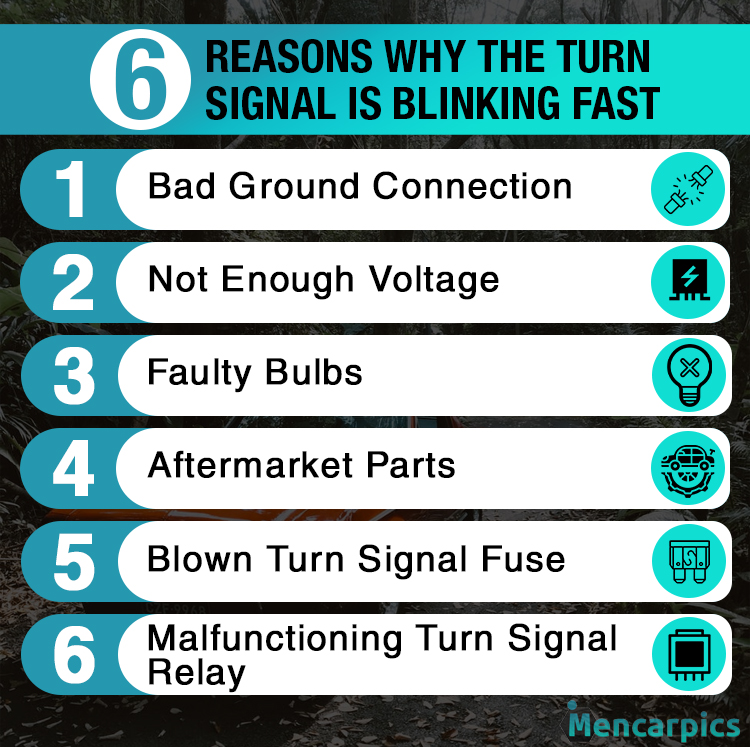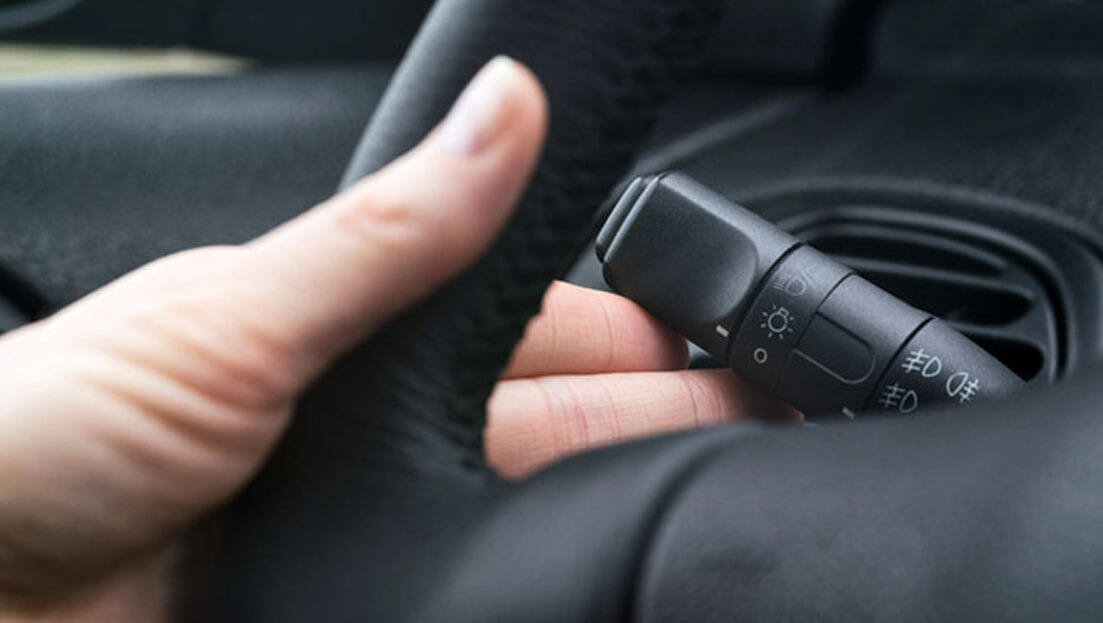The turn signal lights on a car, when activated, flash quickly to let other drivers and pedestrians know that you plan to turn right or left. The turn signal lights have a yellow housing in most vehicles and sit in the car’s corners.
An unusual situation is when the turn signals blink fast, sometimes on one side of the car than the other. Hence, it prompts a question, why is my turn signal blinking fast? Although it is a common problem, identifying the actual cause isn’t straightforward.
This article discusses the reasons for this awkward scenario and how to fix it without visiting an engineer.

How Does A Turn Signal Work?
To know why a turn signal blinks unusually fast, one must understand how it works. The turn signal circuit consists of wires, a fuse, a flasher module, a switch (around the steering wheel), ground, indicator lights (dashboard), and bulbs.
Primarily, power reaches the turn signal circuit (flasher module) through the junction box under the hood or under the dashboard. The flasher module delivers current to the turn signal bulbs by a turn signal switch, which the driver can either toggle up or down.
So how does the blinking happen? The flasher module includes an electrical contact, a bimetallic strip, and a resistive coil. This module employs the principle of resistance and changes its state when power reaches the turn signal bulb.
As current constantly reaches the flasher, a bimetallic strip inside it heats up. The strip expands to close the circuit, sending power to the bulb (with the recommended resistance). The thermal-sensitive strip cools down when the bulb comes on, contracting and opening the turn signal circuit again.
All these happen quickly, causing the blinking, and it continues until the driver toggles the switch back to its neutral position. The standard blink rate range for turn signals is 60 to 120 times per minute.
Why Is My Turn Signal Blinking Fast?

The following are the common reasons why turn signals blink fast.
Bad Ground Connection
The culprit might sometimes be the ground connection. Wires and fuses in the electric circuits associated with the turn signal may break, become faulty, or weaken over time.
Furthermore, some bolts, nuts, and screws in the electric circuit can also corrode, rust, or become loose. Consequently, the turn signal components may suffer from partial connection, especially in the car’s grounding. If you have a basic knowledge of how to test a car ground wire, diagnosing the issue will be easier.
Not Enough Voltage
Apart from a poor ground connection, the turn signal may not receive enough voltage. Voltage issues may occur because of insufficient power from the car’s electrical system, primarily due to poor resistance switches or connections.
Faulty Bulbs
Another common reason for a fast-blinking turn signal is faulty bulbs. That’s right. A bad bulb can affect the resistance in the electric circuit, influencing the performance of the flasher module. The bulb may still power on but abnormally.
Cars with two bulbs installed for a particular direction may also blink fast. This scenario can occur if one of the bulbs is faulty. In short, defective bulbs can affect the flasher relay’s performance, causing it to flash quicker than expected.
Aftermarket Parts
If the issue begins after a repair session or upgrade, one has a vital clue of what to do. In some cases, the problem can arise due to aftermarket parts. Therefore, trace the problem based on the repair or upgrade log.
Aftermarket parts are also replacement parts. However, such parts do not come from the original car manufacturer and with some insurance. Although identical or readily available, aftermarket parts may not meet up with the specifications of the car.
For instance, some bulbs have a different power rating from the recommended option. Hyper flashing can happen if one installs LED bulbs instead of halogen ones.
Blown Turn Signal Fuse
In some cases, a damaged fuse can result in undesired circumstances such as fast-blinking turn signals. In most cars, one will find the fuse under the hood or near the driver’s seat (within). However, refer to the car’s user manual for clarity.
Malfunctioning Turn Signal Relay
A malfunctioning turn signal relay can also be the origin of the problem. The most typical case is the rusted contacts due to moisture, resulting in poor connections. Sometimes, the relay may be insufficient for the bulb’s power requirements.
Another reason for a malfunctioning relay is if it isn’t the ideal one for the car in the first place. Such instances can happen if a driver or car technician does not consider the design settings during replacement or repairs.
How Can I Fix A Fast-Blinking Turn Signal?
Fixing the issue becomes less complicated with a good knowledge of why a turn signal blinks fast. The following procedure should restore everything to normal. Get a multimeter, the car’s manual, a tester, and some screwdrivers to make the process seamless.
Inspecting The Bulbs
Most individuals often attribute this turn signal issue to the bulbs. Hence, it makes sense to start the repair process by inspecting the bulbs in the related electrical circuit.
Observe all the signal bulbs for any strange feature. Check for signs of discoloration, cracks, or damage on the bulb.
If there are no apparent signs to identify a bad bulb, power the car and toggle the switch in one direction. Check the bulbs (front and rear). Change the turn signal to the other direction and observe.
Fixing Or Replacing Faulty Bulbs
After inspecting the bulbs and identifying the faulty ones, replace them with good-quality ones. If the old bulb is the halogen type, never replace it with a LED bulb.
Inspect the bulb sockets using a tester or a multimeter by connecting the probes to the contacts and measuring the voltage. Fix or replace them, if necessary, with the right one. Sometimes, cleaning might do the trick.
Usually, the blinking rate will return to normal except if there are other reasons. Repeat step one to confirm if the replaced bulbs are working.
Check The Relay
The relay might need replacement if the turn signal still blinks fast after fixing or replacing the bulbs and sockets. Most times, the unusual click sound of the turn signals will be inaudible. Purchase a new relay from a credible store or the manufacturer.
Replacing a relay isn’t complicated as long as you can locate it. Just locate the relay under the hood or dashboard, unplug the old relay and replace it with a new one. However, refer to the car’s manual or other associated documents for proper guidance.
Check Damaged Wires
Check out every wire associated with the turn signal circuit, especially if there is no significant improvement. Some wires may be broken or corrupted, causing insufficient current transfer within the circuit.
In some cases, a loosely-connected ground wire can constitute problems; hence, do not neglect the grounding. One can test for continuity on each wire individually using a multimeter and check for current at the contact with a tester.
Read also: What Causes Flickering Car Lights and How Can I Fix It?
Fix Resistance-Related Issues
If there are no changes after doing all those mentioned above, resistance-related issues might be present. This situation can happen when bulbs have low resistance, especially LED ones.
A simple trick to resolve it is to install some inline resistors to match the flasher’s specifications, thus pushing up the bulbs’ resistance.
Conclusion
Like other lights on the exterior of a car, the turn signals play an essential role in ensuring safety and orderliness on the road. Therefore, drivers should inspect and ensure they are in good working condition.
Problems like a fast-blinking turn signal require attention. With this article, visiting an auto repair shop is not necessary except on rare occasions. It explains everything a driver needs to know to determine the causes and fix this issue.






